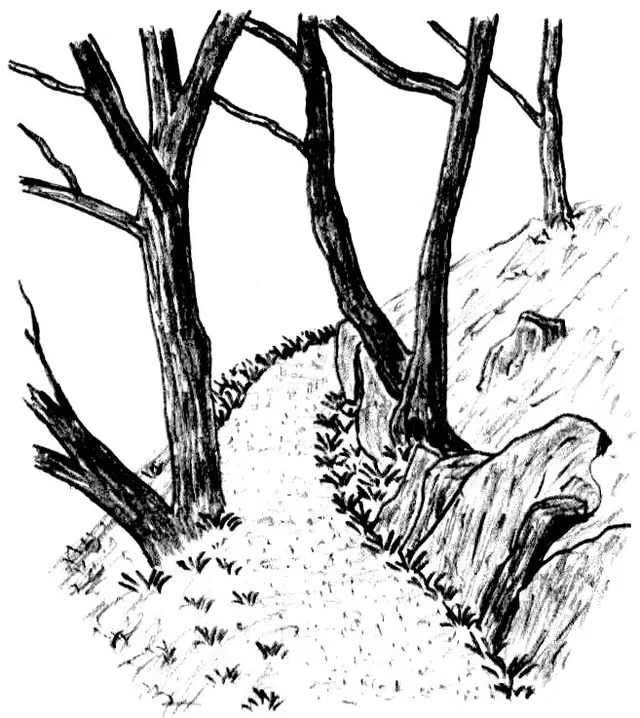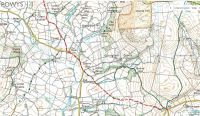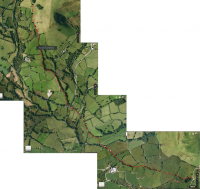The Old Road
Share this page

A number of times over the past dozen years I have been summoned to mid-Wales to undertake a rather unusual Rights of Way survey. It is the same as many others I have done except the paths just aren’t there, so it feels like walking a series of notional lines on a map which may as well have been made up (which in many cases they were, as plenty of Welsh landowners have been keen to tell me). However, every so often – in between vaulting perilous fences, pushing through thorny hedgerows and squelching through knee-deep muddy fields – surprising features are revealed in a landscape that, when I do manage to take the time to look around me, is as beautiful as anywhere I can imagine. There are none of the bare rocks of Snowdonia, but Powys is just as dramatic in its way, a constant procession of smooth hills and deep valleys bounding as far as the eye can see.
One such encounter occurred recently in the parish of Nantmel, near Rhayader. After cutting through a number of barbed wire fences, the notional bridleway I was following reached Yr Onnen, where a bright new redbrick farmhouse stood proudly at the top of one of the fields. The route ignored this and cut through the old farmyard, diving down the back of a ruined barn that was impassable with vegetation and old machinery. The other end of it emerged by the old farmhouse, a ramshackle building that appeared to have been abandoned to the elements and farm animals. I took a photo of the obstructions behind the barn and was examining an old gate when a voice challenged me from behind.
“Can I help you?” This is the more benign of the two usual greetings I get from farmers, the other being, “Hey, what are you doing?”
I tried to explain to an impish man of indeterminate age that the definitive line of the bridleway actually went behind the barn, but he was already heading back into the old farm building, exclaiming “Wait, I’ll get the 1770 map.”

This was not one of the usual approaches and I was impressed by how quickly he reappeared waving a much-sellotaped section of an ancient black and white map. He pored over it, trying in vain to find the farm but, even when I pointed it out, such was the scale of the map it was barely possible to discern a track to it, let alone which side of the buildings it went. Was the barn even that old?, I wondered, but he was already holding forth about the old routes across the hillside that did not match up with these modern footpaths. At least that’s what I eventually discerned but he was hard to follow and I was still trying to work out whether he was trying to obstruct or help me. He was dressed in ancient woollen clothes, a shabby but colourful cardie and a huge home-woven hat that dwarfed his head. The effect can only be described as that of a homeless man, but his look complemented the state of the house from which he had emerged.
I was trying to explain that it really wasn’t important given how obstructed this route was elsewhere and that I only had to record these obstructions as part of my job, when he started marching up the track away from the farm. “I’ll show you what I mean,” he shouted over his shoulder. “You can see the old road from up here.” From what I could gather, he was telling me that the old road led all the way to Maesyfed (Radnor), the then capital of Wales. "It was known as the Old Road, but even the famous book on it – I got that back in the cottage – even he lost it on this section.
“But it’s right here, across these fields,” he announced, pausing briefly to gesture down the hillside. “You can see it, down there in the bog and beyond.” Then he set off again.
For a short man, he walked very briskly and I was at full stride to keep up with him, trying to survey the route as we went. He was gesturing down the hillside as he walked, but there were still so many hedgerows in the way I could make little out. Where a grassy groove forked off up the hillside from the farm track, I pointed out that the bridleway went this way and he seemed impressed.

“The last surveyor that came up here went wrong here and tried to follow the track. But even this is a modern track, it’s not the way they would have gone.” We carried on up what he called a modern track; though it was barely used now, it formed a defined cut into the hillside, the sort that covers the side of hills in mid-Wales and provides some glorious if oft-obstructed walking. Pointing at the nameless hill above, he said, “That’s the sleeping goddess, that is. She’s got a boob there and a hip over the other side. That’s what I call her anyway.”
We were nearing the top of the hillside and the bitingly cold easterly wind was growing stronger. I wanted to stop to put a coat on, but there was no chance to until he finally paused by the last gateway. Looking back across the basin between the hills of Moel Hywel and Camlo Hill, he drew my attention to the line of a hedgerow, to one side of which was a broad holloway running diagonally up the hillside. It was now unmistakeable. “That’s the Old Road, you can see it going all the way down to the bog at the bottom, and that’s the bit the famous writer couldn’t find, but it’s right there. Then it went back up the hill and over towards Pant-y-Dwr.”
This was a route I had just come down and I realised that the broad lonnin I had followed down between the farms of Vaynor was the continuation of this ancient route. It is obvious on the OS map too, a pair of parallel boundaries that looks like a road, but in fact is only a boggy depression filled in over the years by fallen branches. I excitedly told him this, but it was evident he had not ventured that far, though only a mile from his house. He asked if I was coming back down the same way, but I was carrying on over the hills, so he waved me on my way and went back through the gate. He had no interest in impeding my progress after all - he had just wanted to inform me.
That evening I pored over the map and satellite images and traced the clear line of this route that is strangely eschewed by the Rights of Way network. I tried in vain to learn something online about the Old Road or the famous book about it, but could find no reference to it, or work out where it would have been heading in the opposite direction from Radnor. The maps are lacking in placenames in this apparently unremarkable corner of mid-Wales, so my research quickly hit a dead-end. Yet all across the soft green hillsides of Powys, similar tales are worn into the landscape. Many of the impassable footpaths and bridleways I have followed have picked up the lines of similar lonnins and tree-lined trackways, now overgrown, sodden and used only by sheltering sheep. It is one of the perennial joys of this unique job.
